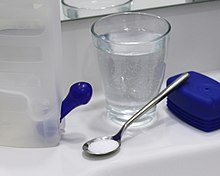Nasal irrigation
A nasal rinse or nasal douche is the introduction of a large amount of aqueous liquid (usually isotonic saline solution ) into the nasal cavity.
Nasal rinses are commonly used as home remedies . Studies with contrary results are available for effectiveness.
indication
The rhinitis is the classic area of application for nasal irrigation. According to a study in which an isotonic saline solution had been used, the extent of nasal mucosal swelling and nasal secretion in children in the acute phase of rhinitis was significantly reduced compared to a control group without nasal rinsing . In the prevention phase , there were fewer secretions, sore throats and coughs, fewer fever-reducing or decongestant drugs had to be used, and there were significantly fewer sick days. A study from Germany comes to a comparable result in adults.
In yoga , nasal rinsing is used as a ritual cleansing technique under the term Jala Neti ( Sanskrit जल नेती jala netī ) and is intended to cleanse the nasal and sinus cavities.
In the case of infections in the nose area, nasal rinsing can also be used for diagnostics in order to identify possible pathogens in the rinsing liquid. For the diagnosis of some viral pathogens (e.g. influenza viruses , rhinoviruses ), this is the method with the highest diagnostic accuracy.
Mechanism of action
The nasal irrigation is intended to replace the mechanical cleaning function of the low flow of fluid on the nasal mucosa ( ciliated epithelium transports fluid and particles) that is present under physiological conditions . If this cleaning function is impaired by dryness, soiling, mucus or as a result of radiation therapy (radiation therapy), pathogens (e.g. viruses) can more easily penetrate the cells of the nasal mucosa and infect them . In addition, the nasal irrigation should increase the activity of the ciliated epithelium. Factors such as natural temperature fluctuations in the course of the year, viruses or noxious substances such as metal, wood or other dusts influence this activity . The latter can even lead to a loss of the cilia of the ciliated epithelium. In the convalescence stage after a viral infection, nasal irrigation can support the restricted self-cleaning mechanism of the nasal mucous membrane. Isotonic saline solutions are typically used as rinsing solutions (corresponds to around nine grams ≈ two level teaspoons of nasal rinsing salt per liter of liquid).
Efficacy studies
Studies in the sense of evidence-based medicine have shown that it is effective with regard to acute symptoms of rhinitis (common rhinitis) and with regard to prophylaxis ( prevention ). But there is also evidence that permanent and preventive nasal rinsing can have the opposite effect: A study by the American Academy of Allergy, Asthma and Immunology found that patients who gave up their habit of rinsing their nose regularly, the Frequency of recurrent sinus infections decreased by 63%.
A systematic review by the Cochrane Collaboration from June 2018 concluded that nasal irrigation could alleviate the symptoms of allergic rhinitis and that side effects are unlikely. The effect of nasal rinsing in addition to drug treatment is unclear, and an assessment as a substitute for such treatment is not possible. Overall, the quality of the scientific evidence is rated as low or very low.
Individual evidence
- ↑ nasal irrigation . ENT practice Dr. Johannssen; accessed on April 30, 2018
- ↑ a b c d e Ivo Šlapak et al .: Efficacy of Isotonic Nasal Wash (Seawater) in the Treatment and Prevention of Rhinitis in Children . In: Arch Otolaryngol Head Neck Surg. , 2008, 134 (1), pp. 67-74.
- ↑ a b c d T. Schmidt et al .: The GEK nasal douche . 2003, study. ( Memento of July 9, 2007 in the Internet Archive ; PDF; 743 kB), final report, part 1. ( Memento of July 9, 2007 in the Internet Archive ; PDF; 798 kB) and final report, part 2. ( Memento of July 9 2007 in the Internet Archive ; PDF; 254 kB) accessed on December 12, 2008.
- ↑ Sarah Allemann: With salt water and a rubber hose against the dirt in the nose . srf.ch, October 7, 2013, accessed on January 9, 2016.
- ^ Core Reading List . (PDF; 1.7 MB) American Academy of Allergy, Asthma and Immunology; Retrieved April 22, 2012.
- ↑ Nasal rinsing only in acute cases - Do not use preventively . Apotheken.de; Retrieved April 22, 2012.
- Jump up ↑ Karen Head, Kornkiat Snidvongs, Simon Glew, Glenis Scadding, Anne GM Schilder, Carl Philpott, Claire Hopkins: Saline irrigation for allergic rhinitis . In: Cochrane Database of Systematic Reviews . No. 6 . John Wiley & Sons, Ltd, June 22, 2018, doi : 10.1002 / 14651858.CD012597.pub2 (English).



